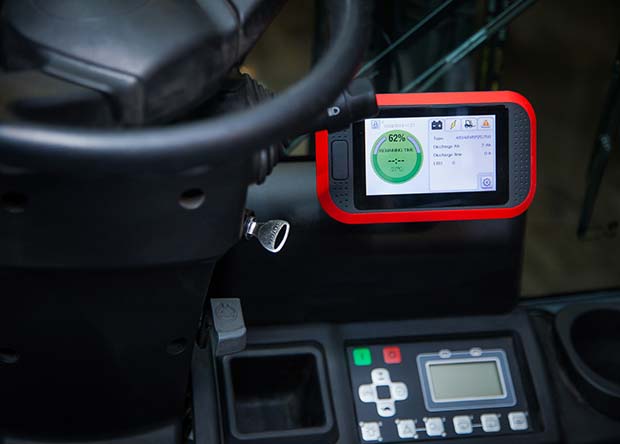Matteo Todesco, Senior Marketing Manager Motive Power, EnerSys EMEA: Modern warehouses typically rely on electric material handling vehicle fleets, with associated motive power batteries, chargers and battery handling devices that need maintaining. Keeping them in optimum condition makes sound financial sense. Firstly, wellmaintained batteries and chargers last longer, are more reliable and allow direct cost-savings. Additionally, any shortfall in battery reliability impacts lift truck availability and an operation’s overall productivity.

While it’s an attractive concept, improved battery management often requires more information than most users possess. Even if individual lift truck data is available, understanding and acting on data from tens or hundreds of batteries is difficult. The challenge therefore, is to collect all battery and device data into a single, integrated platform.
While many warehouse operators believe that solutions either do not exist or are too expensive, an effective power management system is in fact available: one that gives electric vehicle users – from drivers to fleet managers – the insights they need to make productivity improvements and cost savings, without undue risk, installation costs or complexity during operation. This article looks at the issues that adversely affect battery performance and how a power management system can mitigate these. It shows how, to ensure success, such a system must be supplied as a service from a capable supplier rather than just as a set of components. It then reviews an integrated power management solution that allows fleet operators to maximise their profitability, while ensuring predictable costs and sustainable productivity.
Battery and charger performance issues
Excessive operating temperatures can reduce battery operating life, or even cause failures. Insufficient water topping-up, poor equalisation and under-performing chargers can also cause problems. Insufficiently trained operators may under- or overcycle batteries, leading to unequal utilisation.
Power management v Fleet management
The term ‘fleet management’, as widely used by materials handling vehicle OEMs, typically covers vehicle location, safe deployment and shock detection. Battery status reporting, if available, is not typically the main focus of these type of fleet management systems.
In this context, a better approach would focus entirely on energy and power management. And this becomes possible if the solution provider is sufficiently experienced in delivering energy and power storage devices and systems. One integrated solution combines innovative batteries and chargers with IoT wireless sensors and cloud-based software. The system provides actionable insights within easily-readable reports. The reports, accessible via PC, tablet or smartphone devices, are available to users anywhere, in real time. The data can also be delivered wirelessly to a dashboard-mounted display module in each vehicle, allowing drivers to see and respond to battery status issues in real time.
This approach gives users a much deeper understanding of their material handling vehicles’ battery performance. It also provides advice on how to successfully manage an entire battery fleet and optimise its performance.
What insights can a power management system provide?
Wireless battery monitoring devices, positioned on each vehicle battery, measure temperature, water level, discharge current, charge current, cell voltage imbalance and state of charge. This allows a cloud-based battery operations management system to alert supervisors to batteries with either actual or potential problems, or, crucially, to impending failures.
The system contributes to process improvement as well as highlighting individual battery problems. By revealing optimal battery charging times, double-cycling can be practically eliminated; batteries become more equally utilised.
Optimal battery charging practices are highlighted, while the best charging room and opportunity charge points are identified. The system also recommends on fast and opportunity charging opportunities, and partial State of Charge (SoC) operation. Battery wrong-sizing and low run time batteries can be identified, together with efficient intervals and water levels for flooded lead-acid battery topping-up.
Truck kWh energy used during truck operation and charging is revealed, allowing assessment of entire fleet overall energy use. How the system delivers its benefits EnerSys®, which specialises in stored energy solutions including motive power batteries and chargers, delivers these benefits with their Xinx™ battery operations management system. Its user value is driven by the quality of data it collects, its ready availability at any location, and the depth of insight it enables analysts to provide.
Vehicle battery sensors transmit data using Bluetooth Low Energy protocol to a Wi-iQ® battery harnessmounted monitoring device. This communicates via a gateway to the Xinx™ system’s cloud server, using a local LAN or 3G/4G modem. Its output is also available as raw data to the Wi-iQ® battery monitoring device report suite for user analysis.
The Xinx™ online portal presents comprehensive battery information, including voltage balance, daily usage and rotation, water levels and other efficiency parameters, in an easily-understood, actionable format. An analyst can evaluate these process and asset issues regularly, identifying root cause and actions for optimisation; efficiency optimisation plans can be posted to the portal to notify management.
The analysis facilitates forecasting as well as process improvements. The portal can show required battery actions, and allow an analyst to assist with annual battery budgeting. The Wi-iQ® battery monitoring device report suite provides similar insight at more modest engagement levels. The Wi-iQ® battery monitoring device also communicates with smartphones and tablets through the ENS Connect mobile app. It can download and display historical data, and forward it for deeper analysis. The app also manages vehicle-mounted battery chargers. Finally, the Truck iQ™ smart battery dashboard, if fitted, provides another, driver-oriented, view into battery status at a per-vehicle level.
Conclusion
This article describes how a power management system can help warehouse operators who are seeking to improve motive power battery efficiency. The system provides comprehensive coverage, from truck to cloud, and depths of insight into real-time battery status that were not previously available. By highlighting problems related to both battery health and operator behaviour, battery runtime and longevity can be vastly improved. Additionally, the actionable insights provided by the management system fully support higher-level decisions and management processes. As a result, battery and charger fleets can be correctly sized, and budgeted for, based on actual usage.
ENERSYS




Comments are closed.